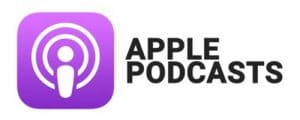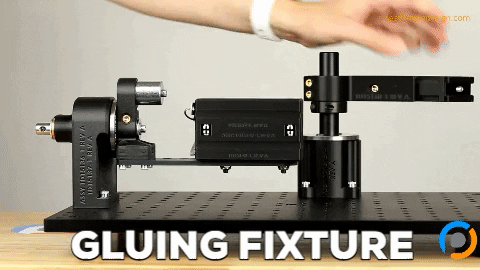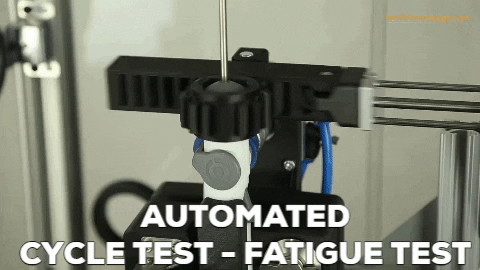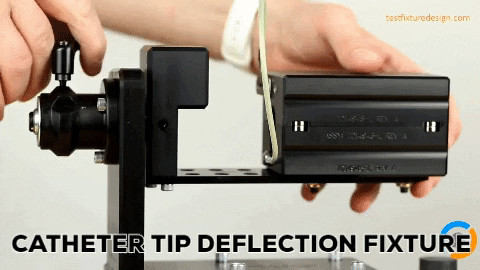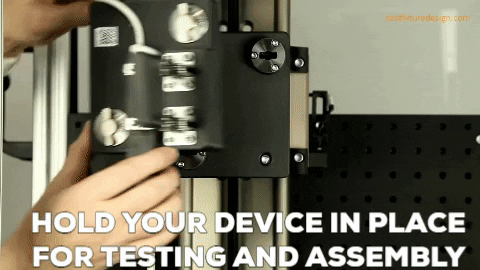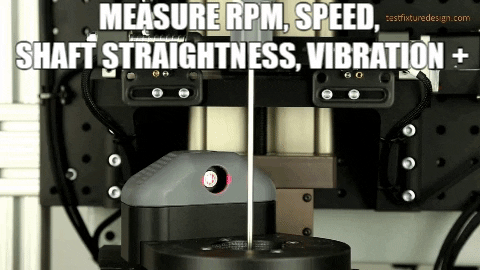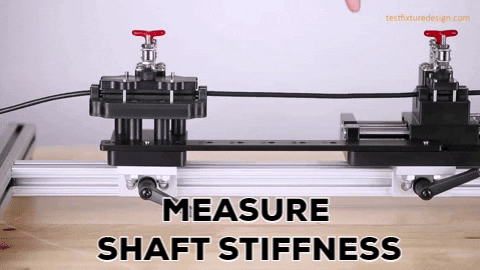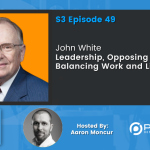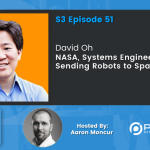Chris Denney | PCB Design, Fabrication, & Manufacturing
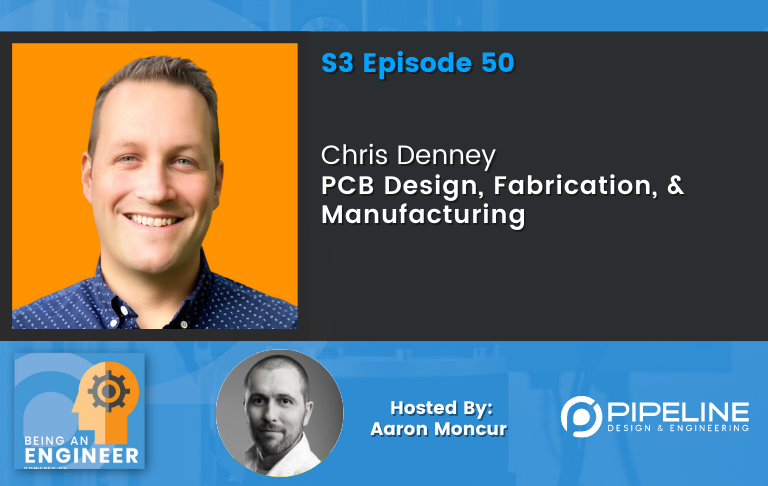
Who is Chris Denney?
Chris Denney has a degree in electronics engineering and is CTO at Worthington Assembly Inc, where they specialize in small-volume prototype and production runs of highly complex printed circuit boards, or PCBs. Chris is also a cohost at the Pick, Place, Podcast where they discuss the PCB assembly process and design tips that will make your manufacturer love you.
https://circuithub.com/
Aaron Moncur, host
EXPAND TO VIEW EPISODE TRANSCRIPTION
Aaron Moncur: Are you looking for a reliable machine shop or maybe you need to find a Metrology lab or perhaps a service provider for scanning and reverse engineering. If you need to find vendors for your engineering or manufacturing project, visit vendors dot Team pipeline.us. It’s free and helps you and your team find great vendors to help you succeed on your projects. You can also share a few of your favorite vendors with the community. That’s vendors dot team pipeline.us Check it out today.
Chris Denney: Once you get to the point where you do have to hire a manufacturer for whatever reason, because the technology, the volume or whatever else, understand that manufacturers are very, very good at what they do, and rely on them for their expertise.
Aaron Moncur: Hello, and welcome to another exciting episode of The being an engineer Podcast. Today we’re speaking with Chris Denny. Chris has a has a degree in electronics engineering, and is CTO at Worthington assembly incorporated where they specialize in small volume prototype and production runs of highly complex printed circuit boards or PCBs. Chris is also co host at the pic place podcast where they discuss the PCB assembly process and design tips that will make your manufacturer love you. Chris, welcome to the show.
Chris Denney: Thanks so much for having me. Aaron. Yeah, that’s a good point. Make your manufacturer love you. That’s That’s what everybody wants, isn’t it?
Aaron Moncur: Yes, it is. That’s always a good sign for sure. So Chris, what what made you decide to become an engineer?
Chris Denney: You know, I’ve been planning on my response to this ever since I started listening to your podcast because I’m thinking I don’t know. And I think that’s a response a lot of people have, right. I when I was in high school, I just needed the gas money, right. And I worked at this contract manufacturer. And I met some of the engineers there and thought what they were doing was pretty cool. And decided to get a degree in it and stick with that. But I mean, like, like most people like that you’ve interviewed, you know, we all play with Legos and connects when we’re a kid. And you know, and that carried on even like in video games, like I love like SimCity and RollerCoaster Tycoon like no, my buddies are playing Yeah, HalfLife and Halo, and I’m like, trying to build the coolest roller coaster. You know, I don’t know. It’s just, it’s in the blood, I suppose.
Aaron Moncur: Yeah, I was always into Tetris. That was my video. Oh, yeah.
Chris Denney: Oh, yeah. I never had the reflexes for that. But you know, I just couldn’t like I’d get the level like eight and I just could
Aaron Moncur: see, that’s why you went into electrical engineering. I went into the category. Yeah, I suppose that’s it. All right. Well, how did you get started as CTO at Worthington assembly?
Chris Denney: Well, I went to work for a startup after graduating from college. But they made equipment for electronics manufacturing, that’s what they did, and got to visit like all these super cool factories all around the country, Mexico, Canada, really just like thought, like blew my mind as a young person and not having really been exposed to any other manufacturing. Besides this one company I worked at through through high school and college. And, and then I went, shortly after that I got recruited by a sales rep firm, that I don’t know if, if your listeners are familiar with with independent manufacturers reps, but they they get their business models, they get commissioned by selling machines. And so they hired me to help sell machines and turns out to a much better engineer than I am a salesperson. So the folks that weren’t in assembly, we’re looking for somebody to help them grow their business. They were very, very small at the time. So it’s not like we’re significantly larger now. But I think there are about 10 people at the time, and had got bought by new management, and were interested in working with me and 11 years later here, we are still doing it. Wow.
Aaron Moncur: What do you think it was about the way you presented yourself or your background or experience where the leadership at Worthington said, Yeah, yep, you would be perfect here.
Chris Denney: So the owners were, you know, they’re, they’re not manufacturing people themselves in the sense of like, they’re not engineers. They’re not running machines. It’s not, you know, they’re perfectly capable of doing it. It’s just not what they’re interested in doing. They’re interested in running the business and hiring the right people to take care of all the other stuff that they don’t want to have to worry about. Right. That’s that’s business one on one, I suppose. And just I don’t know, you know, we’re all young. We’re close to the same age, enthusiastic. i Passionate. I’m passionate about the industry, I really enjoy it, I really like it, I like all the aspects of it, that can come through in conversations in, we just, we just hit it off, you know. And also, because of all the traveling I had been doing, and all the factories I had been visiting, I was chomping at the bit to improve, implement these things I had seen, and to steal ruthlessly, so to speak, right and, and take all these great ideas and implement them somewhere and see if I could do it too. And it was just, it’s, it was a really exciting opportunity. And everybody just wanted to make it successful. And you know, it’s just being a small company being a 10 person company, it was also like a great opportunity to just kind of like almost like a sandbox, you can you know, without with very limited capital, obviously. But you could do almost anything you wanted, you didn’t have a ton of bureaucracy had to go through. So it was just really exciting to like, hit the ground running and start to make change and start to make improvements. And it was just really exciting.
Aaron Moncur: I love that. One of the things that you mentioned that stood out to me was, you all got along really well. I think it’s it’s maybe an underappreciated skill, just getting along with people. There’s a good friend of mine who used to be a customer and and he’s no longer a customer. But he’s a good friend of mine. And he was visiting just last week, we’re walking around, and he’s he’s done well in life has done really well. And I said, Hey, what do you think it is? Like, what do you attribute this success to that that you’ve realized in life? And he says, Well, I think two things. One was that, basically, since I was a very young adult, in fact, maybe even slightly before he was an adult, he was kind of on his own as far as figuring out how to pay for life. His parents didn’t have a lot of money. And so he figured out, you know, he worked three, four jobs to put himself through college and things like that. He said, That was one of the big things, just learning at a young age, how to figure stuff out on your own without having to rely on other people to show you what to do. But the other thing he said, which I think is equally important, is he’s always been really nice to people. That’s, that’s come back, you know, to him. Full circle, right. And I just think that’s it’s such an important thing. It’s, in theory, it’s really easy to do just to be nice to people and get along. So anyway, that for sure. I think that’s a really important point there.
Chris Denney: Yeah, we we get along great. I, you know, the owners of the company. And myself, we have to work really, really closely with each other like and really have really difficult conversations and call each other out when we’re when we think we’re making the wrong decision. And the great thing is the three of us have had the right personalities to be able to accept that right into for them to tell me like Chris, no, you’re going in the wrong direction here. And, and vice versa. And having the ability to listen and respond to that appropriately. is really, it’s one of the hardest things in the world. But it can be so powerful when you pull it off, right?
Aaron Moncur: Yeah, yeah. And I feel like it’s easy to say, Oh, sure. I listen to people I take people’s feedback and really listen to it. But it’s one thing to say that and another thing to actually do it like you say one of the hardest things in the world, because we all have our blinders on. Right that we think what we see is the right way. But yeah. Well, what, what kind of of PCB manufacturing is Worthington really good at? And is there a type that it’s not so great a fit for your company?
Chris Denney: Yeah, so it’s important to keep in mind that we are not a fab. So we’re not making the bare circuit board, where it takes we’re ordering. And we’re partnered with the bare circuit boards, and we’re doing the assembly, the soldering of all the components on top of circuit board. And those are kind of two different disciplines. And usually you find most businesses are one or the other, and they partner with each other. There are plenty that do both. And we have a hope and a dream that someday we’ll be able to do both. We would love to have in house capability to do our own PCB fab. Oh, we do assembly. So I just wanted to explain that because it’s important to know the differences because that’ll set off the rest of these conversations, right? In the
Aaron Moncur: fab part, you’re talking about, like cutting out the blanks of the board, right?
Chris Denney: That’s right. Yeah. So it’s in its, that’s right. Yeah, the blanks of the board and it’s before you put all the capacitors and resistors and microprocessors and everything on. So we, we’d like to call ourselves glorified solders it’s all we do. We just make solder. We just make the fab folks there. They’re buying the raw material. They’re chemically etching and drilling holes in plating and doing all that kind of fancy stuff with all those chemicals and got it. Okay. Sweet spot for us. We’ve always been really, really good in that one piece to 100 piece range. It’s kind of But it’s kind of a market that the United States continues to have pretty good strength in, because we have a lot of innovation in the United States still. And those innovators need prototypes, and they need ways of proving out their ideas. And so the market is quite strong for that, for those needs here. But lately, I’d say, particularly like, since the pandemic, I have no idea why, you know, we can theorize all day long, but we’ve seen more and more demand for increase in volume. So you know, going from, you know, we get the occasional 1000 piece order here and there 500 pieces that was very normal, you know, we would get one of one of those a week or a couple of those a month, something like that. But now we’re seeing them like, regularly, really ready. Oh, wow. And we’re seeing customers, they’re like, you know, I need 10,000 of these a month. And that’s, that’s a, that’s a different challenge for us. But a really exciting one. Not, we don’t necessarily know if it’s a financially exciting one yet. We don’t know we can be real competitive. But from an engineering standpoint, it’s really fun, because it’s totally different challenges, right? Like, when you’re building like two boards, if you don’t, if there’s something weird about apart, you’ll make it work, you know, you’ll stand a little bit here, you’ll polish off a little bit there, you’ll hand play something rather than use a machine. But then when you have to build 10,000, something that’s not quite right becomes like, a huge deal, right? So the the challenges that that come with all that kind of volume has been really exciting to tackle it really, the sort of, I don’t know what it is, you know, that that tickles that part of the brain where like, you make a small change that has a big improvement, and you see that cascade over 10,000 pieces. It’s just like super thrilling to see. So that’s, that’s been a lot of fun. Something we’ve been we’ve we’ve been able to challenge ourselves with a lot more lately, and so far, been successful with it. We’ll see how it goes long term. But yeah, we’re enjoying it. But still, the one piece 200 piece range is still kind of our sweet spot, but we’re looking forward to the new challenge.
Aaron Moncur: Super exciting. So we’re equipment people here at pipeline, we love building new custom equipment, which made me wonder, what what does the equipment look like for fab and pick and place and all that stuff associated with producing PCBs, especially at well, actually, not especially both in the lower you know, small volume prototype range, as well as the higher volume range.
Chris Denney: It’s, it’s some of the coolest equipment I’ve ever seen in my life. And it’s probably part of the reason I’m still in it. Because I just find it so cool. Like, I’ve never like I find machining equipment pretty neat. Like your Haas machines in your that’s the only brand I know I think really because of my Formula One fan. It’s about the only reason I know what a Haas machine. The those are neat, but like I’ve always been turned to turned off by like, the smelliness of them in the end, that Smell, smell but like I don’t think I want to experience it all day long, right? Like I love how like clean and tidy the equipment is that we use. But the pick and place machines that we we operate are definitely like kind of a thing that people really think of when it comes to electronics manufacturing, picking components up and placing them onto the circuit board. And it’s hence the name of our podcasts big plays podcast because it’s sort of the heartbeat of every manufacturers operation. Do yourself a favor and just Google pick and place machine and just allow the algorithm to wash over you man it is just like watching these machines run is super super cool. Because there’s so crazy high speed. We bought some new machines recently from a Japanese manufacturer, some of the fastest, most amazing machines in the world. They will place if I have if I if I have the numbers right they’ll place 55,000 components per hour. And that’s staggering. It’s staggering and it’s it’s so fast. Your your your eyes cannot keep up with it. Like like oh my gosh, even a high speed camera so I was having an issue with it recently I was having trouble with anyway, I won’t get into the details. But I took my iPhone and I set it to 240 frames per second. And I put a big light on it. And then I recorded it I’m thinking 240 frames a second I’ll figure out what’s going on. No it just laugh that is so much faster than even a high speed camera. It’s really really, it’s it’s quite cool. But in a low volume manufacturing operation. and a high volume manufacturing operation. You’ll see basically all the same machines. I mean, you know different manufacturers but you’ll see you’ll see stencil printers you’ll see pick and place machines you’ll see reflow oven This selective soldering machines, three, three dimensional automated optical inspection machines, you’ll see all these same machines, no matter kind of the size of the operation. This is because the technology kind of demands that you kind of can’t build these things without having all of the right equipment, you limit yourself to the kind of tech that you can, you can do. So for example, like, the machines we just purchased are, it’s an open secret that they that they were more or less designed for Apple to build the iPhones and iPads and stuff like that. And then, you know, they sell, you know, many 1000s to Apple, but they get to take that design that they engineered for them and solve everybody, right. So so we have the capability now to build almost anything, right? You The only thing that you might have from say, a smaller shop, say like us 10 years ago, we just couldn’t build the really tiny stuff. It’s more of like a capability limitation than anything, but you’ll still see a stencil printer, or pick and place machine or reflow oven, like you still that process is still so proven and solid and reliable. The days of like, you know, plywood, work benches and soldering irons, assembly, new circuit boards are kind of a thing of the past, because the components are just so small now, right? If you build in a relatively simple board, you can do that. And trust me, I’ve done it because I’ve done design work. And it’s like, I don’t want to tie up this pick and place machine This million dollar assembly line to build just two prototypes here. Because I’ve designed it in a way that I can build it. Like I designed the parts large enough that I can build it myself. But if it’s if they were too small, I’d have no choice, we’d have to build it on a machine, you know, so. So that’s what you start to see. I don’t know if you this is a visual medium or an audible audio medium so I’m not sure I could really describe what they look like but they are cool to watch I not sure what else I’m
Aaron Moncur: gonna go Google that are on YouTube and find some videos after I do this. The the components do they come on on reels is that how they’re typically supplied. And then the pick and place machine will pick it off the reel and then place it onto the board.
Chris Denney: Yeah, the history of this is actually super fascinating it It started out I don’t want to go too much of the history because we could spend the next 45 minutes in it, but the surface mount technology went when they when they were developing the ability to place components on the surface of a circuit board rather than through the board. They needed a way to feed these pick and place machines and they actually look to the film industry because the film industry had this, these these tapes and these reels to hold film. And so they adapted that technology to hold components. And so if you’ve ever seen you know kind of the kind of the iconic movie theater projector film can kind of a thing it doesn’t look too dissimilar from that really interesting, you know, much lower cost. It’s not the really fancy you know, photo film that they use but but yeah, so they come in like a kit, excuse me like a like a carrier tape with like an embossed carrier tape. And then they have a very thin film of like a mylar tape that goes over that so they don’t fall out. And then those get loaded into what’s known as a feeder which is its own machine in and of itself. These are pretty sophisticated fancy little tools they have they have computers built into them well microcontroller very simple computers built into them and all kinds of machinery to to advance those tape and just pull off the cover tape and and then those get loaded into some kind of a cart and then that cart gets loaded into the machine and and then the machine has a head on it that’s that flies around and an XYZ robot and that head usually have many many many tools for picking the parts yeah not just one
Aaron Moncur: of them. So it’s got to be tiny tools. I mean, some of these parts are really small.
Chris Denney: Yeah, so the the head itself what like the smallest head the smallest head itself will hold about a seven millimeter tool. That’s the tool though. That’s that’s the tool going inside the head. The tip of that tool the tip that I was actually making contact with apart the smallest one that we have is point three millimeters outside diameter the outside knife means I’m gonna meter Yeah, like and they’re machined their machine from some kind of crystal that too because they’re super super hard. So that so that they last basically indefinitely so they don’t wear out.
Aaron Moncur: Yeah, and what is the mechanism by which they pick things up? Is it is it like suction vacuum? Yeah, yeah, it’s vacuum. Yeah. Okay. Okay. Wow. Going through a point three millimeter od to Yes. I don’t know what the idea is there. Yeah, amazing. All right. I, I’m gonna have to fly out there one of these days and just to your factories. See all this stuff in person. sounds so cool.
Chris Denney: There’s a couple, like, there’s a couple of videos of our of our factory on our YouTube channel, but it’s been, it’s been a long time since we took a good one, we want to do more especially now that we have this new equipment, we really want to show it off. And, and because it’s, it’s, it’s pretty cool. If you if you do Google, like I recommend searching on YouTube or whatever for pick and place machine, or SMT, use the term SMT pick and place machine. But the two, the two in particular that are kind of the most visually stunning are one of the older ones from the 90s was was called a CP six, as in Charlie, Panda six Numeral six, those were kind of like the, in the heyday of SMT. In the 90s. Like they were the they were the bread and butter, those those machines were absolutely insane. But they were built to just run and run and run and run, you could you could not like, if you wanted to run a different job, it’s gonna take you eight hours before you can get up and running on a different job the way more modular way more flexible, you can change them over and just a few minutes. But they’re not quite as visually stunning is the old CB six machine was.
Aaron Moncur: Okay, cool. Well, what are some of the typical lead times associated with getting a custom PCB? I’m sure it depends if you’re getting one or 1000, or whatever. But
Chris Denney: yeah, so. So typical, if you’ve got more money than, than Apple, then you can you can afford to get them in 24 hours, we have actually done we have done that’s gonna be a no for most of us, most most people we’ve done some is quick is as quick as three days, that is possible, we have a very limited capacity for doing that. And that fills up each day pretty quickly. But the general what you usually expect is like 15 to 20 days, if you’re not if you don’t want to spend a fortune, and I’m talking business days, by the way, these are all business days, okay, 15 to 20 business days, that’s kind of the, that’s kind of a sweet spot for most people from a cost benefit, you know, perspective, honestly, even 10 days, usually, you know, you can get it done. The thing is, it’s all about Part Availability, and whether or not you can get the parts and what the market is like, and right now, it’s it’s a complete disaster. So, you know, say, assuming all parts are available, those are the numbers. And then from there, it’s, it’s, you know, whatever it’s like if you can get the parts, as soon as the parts arrive, then maybe, you know, five business days or something like that, once we have all the parts in the building, you know, five to 10 business days once all the parts are in our building.
Aaron Moncur: Got it? Okay, so what are some of the biggest technical challenges in PCB manufacturing?
Chris Denney: Size, right, everything getting so small, is really, really quite challenging. It’s, it’s like, it’s not that it’s, it’s not that it’s like any more challenging than anything else, it’s sort of just, you have less, less less room for error. So so if you’re, you know, say you’re an archer, and you’re trying to hit your target, if you’ve got a, if you’ve got a 12 foot target, you’re gonna hit that thing all day long, right? If you’ve got a two inch target, it’s going to be much harder. And yeah, making sure that you know, your manufacturer has the right equipment to hit that two inch target is, is going to help them be successful. And that’s kind of the most challenging thing we run up against. But honestly, for the most part, like, that’s not really what we struggle with. What we struggle with more than anything is park management. It’s it’s because you got to understand, like, we’re gonna build a job on Monday, because today’s Wednesday, and then we have Thanksgiving, and so we’re gonna build a job on Monday that has 229 unique parts on it.
Aaron Moncur: You just want a sense for where that where that lies in the range of complexity is that medium complexity high? It’s doesn’t sound like low,
Chris Denney: but it’s it’s high. Yeah, it’s high. And I would say I would say it’s on the low end of high complexity, because I’ve heard of some I’ve heard of some boards that have like over 1000 uniques. But those are very rare. Those are those are the the point 001 percentile, I would say, okay, high complexity, you’re you’re over 200 uniques is your bread and butter. This is a highly complex job over anything over 200 uniques if you’ve ever seen in Arduino, or Raspberry Pi, or something like that, these are kind of like very popular microcontrollers, a lot of people integrate into their projects and stuff. Those are fairly low complexity. Those are probably maybe 30 or 40 unique part numbers. That’s very, very simple. Kind of do all day long. We tend to do anywhere from from that range up to like 100 seems like almost all jobs are somewhere in that range up to 100 120 over that it starts to get more complex. And the biggest issue with having all these unique parts is like you have, you have to manage each one, you have to you can’t lose them, right? Just job one don’t lose the parts. And these are tiny, right. And so you have these carriers. And even it just becomes, it becomes sort of a logistical. I don’t want to use the term nightmare, because it’s what we do every day, we’re not living in a nightmare. But it’s a, it’s a logistical problem that you have to be very disciplined to maintain and make sure you can identify all these parts, that they’re the correct parts, they’re labeled properly, they’re where they belong. So that by the time you load them on the machine, you’re putting the right part in the right place. Because most of these parts look absolutely identical. They are visually 100% identical, you cannot differentiate one from the other. But electrically they’re quite different. So then you have to have the right equipment to identify them electrically before you place them on the board. So our machines have electrical verifiers for those sorts of things. But, you know, it’s it’s the logistics of managing the complex. You know, the parts, I mean, we have something like I think we have like over 60,000 unique parts in our database that have, you know, unique parts have come through our factory over the years. That’s, you know, at the end of the day, it’s we say that all we do is make solder joints. We’re really all we do is manage parts.
Aaron Moncur: Sorry about that? Yeah. Oh, that’s a very interesting insight, I can appreciate that. We, we just finished the job a little while ago, where we had something like 300 unique parts and a little over 700 Total parts. And that was just the custom stuff, not not the COTS, not the screws and nuts and things like that. And we ended up having like, eight tables just covered with all of these parts, right? And signs for which parts came from which vendor and things like that. And these are big parts that you can easily look at and say okay, yeah, this is part number XYZ or This is part number ABC. I can’t imagine the complexity that goes on managing that level, that number like quantity of parts when they’re so tiny and in not differentiable.
Chris Denney: Yeah, it’s it’s a headache, for sure. You know, and that’s why carriers become very important the carrier that we put them in, you know, the reels, the bags, the trays, these sorts of things, and having those clearly labeled, and then don’t get me started on moisture sensitivity. That’s a whole CBT. I mentioned earlier, there’s ovens involved in the manufacturing process to melt the solder. Well, it’s a mass, it’s a mass soldering process. In other words, the entire thing is soldered all at once, as opposed to individual solder joints, like you would do with hand soldering. And so these moisture sensitive devices, they’re, they’re hydroscopic, basically, or they’re, there’s materials in them that allow them to absorb moisture. And then that moisture gets trapped. And then you put them into an oven. And guess what happens? Pa literally, it’s called pop corning, if you manage your moisture sensitive devices properly. So you have to you know, there’s a clock that starts ticking as soon as you open that bag, you have to get that thing into a reflow oven before it pops. Interesting. Yeah. And so, you know, running against that clock is a lot of
Aaron Moncur: fun. Quote, unquote, fun. Yeah.
Chris Denney: Anyway, well just think about it, the most stressful situations you’ve been in life, usually there’s a clock involved, right? You’re trying to catch a flight. It’s always you know, there’s a deadline, you’ve got to get to the airport, you got to get through security, and it’s the most anxiety inducing process. And in manufacturing, when there’s a clock like that, it it can be stressful. And you know, sometimes that clock is less than 24 hours. And so we have to, you have to get the whole you have to set up 229 feeders and and don’t open the moisture sensitive devices till you’re ready to run. You know what I mean? Like all these and then yeah, and then if it’s a double sided board, it means you have to put it through the reflow oven again. The clock is still ticking, even though it’s gone through the oven. Once it’s still ticking. It’s still absorbing moisture. You got to get it through again. Wow. It’s anyway it’s yes. So park management. It all comes down department
Aaron Moncur: complexity there. Wow. Okay. Well, I’m gonna take a real short pause here and share with the listeners that Team pipeline.us is where you can learn more about how we help medical device and other product engineering or manufacturing teams develop turnkey equipment, custom fixtures and automated machines to characterize inspect, assemble, manufacture and perform verification testing on your devices. We’re speaking with Chris Denny today. So Chris, what? Sometime sometimes I talk with machinists, who are making mechanical parts, and they’ll lament to me. I had to make this part the other day and I think the designer was just out of school or something, because there were sharp internal corners, and they’re impossible to make. And you know, this and that I’m sure that that analog exists for PCBs as well, what what are some of the common mistakes that engineers make when designing PCBs?
Chris Denney: Man, I’m gonna try to keep this short, you know? Where do you start? Yeah, where do you start? I mean, really, the biggest thing is just making too many assumptions, right? And it’s like, then. But when you’re naive, you don’t even know what you’re assuming you know what I mean, when you’re starting out, you don’t even know what you’re assuming yet. So most of
Aaron Moncur: the most common My heart goes out to them rules of thumb,
Chris Denney: just don’t use the tiniest parts that you find, right. So if you can fit the part on the board fit the part, don’t don’t try to go using the tiniest, you know, because there’s components we use that are point two by point one millimeter. in size, right, that that’s, it’s insanely small, and it’s in those parts are insanely difficult to build. And they’re expensive and require special tools and on and on and on, if you can fit the part fit the part. So don’t try to use tiny, tiny parts all the time. The other thing is, you know, we have why this is this could this could go down quite a rabbit hole. But there’s, you know, we have machines to handle boards. So a lot of times people when they’re designing circuit boards, they’re they’re, they’re probably used to ordering them themselves and building some prototypes on the workbench, this is a very common thing, a lot of novice engineers do this, a lot of college students do this. Totally, totally normal process to go through. And hugely valuable, I cannot recommend you do this enough. Because it you learn so much into this process about your own design and mistakes you’ve made, the assumptions you’ve made. And you’ll learn on your own without upsetting the Chris Danny’s of the world, right. But once you get to the point where you do have to hire a manufacturer for whatever reason, because the technology, the volume, or whatever else, understand that manufacturers are very, very good at what they do, and rely on them for their expertise. And what I’m getting at here is when you’ve ordered those circuit boards, to hand solder yourself, those are for building on a workbench and hand soldering, those are not for manufacturing, the circuit boards that you buy from very popular businesses like OSH Park and JLC. And there’s qith, there’s a huge one I can’t think of the name of anyway, there’s these popular and they’re great, you get like five boards for five bucks, they’re, it’s insane how you can get these things, right. And that’s what we’re used to. But those are unusable in a manufacturing operation. They don’t have the necessary breakaways, they don’t have the necessary visual indicators for the machinery to, you know, to identify where’s this board inside the machine? You know, there’s all these features that we need, that those don’t have. So so often, you know, we have to break the news to these poor people, like, Hey, I ordered 100 circuit boards, I’m gonna send them to you, can you build them for me like, we can’t, we can’t use those. Like, we can’t use those. Literally, it will be cheaper for us to buy brand new circuit boards than it will be for us to try to manage those boards that you’ve already ordered. So that’s a common mistake. We see a lot of times people trying to send us and I’m talking about the bear. Remember, we talked about the fab the bear circuit board first before we saw all the components on it. So yeah, making making that assumption can be can be difficult. I wrote down a couple of things, I just want to touch on them. Oh, that’s what it was. So we actually, there’s actually an entire episode of our podcast kind of dedicated to this topic. Okay, yeah. About, you know, small decisions that you make in your design process to have a big impact in manufacturing. I looked it up before we started recording, Episode 29 of our show is a good reference. And it’s all about kind of like the big heavy hitters that really are quite challenging about things. But I guess at the end of the day, you know, we always sort of a catchphrase for our show is make it bigger and have a conversation. So that’s great. If you’re, if you’re interested in having if you’re interested in hiring a manufacturer, I don’t care if you’re seeing seeing apart laser cutting, whatever, right? Assembling a circuit board, call the manufacturer before you’re really ready to hire the manufacturer, and ask him some of these questions. You know, and you’ll save yourself a lot of time. I know conversations can be annoying, and nobody wants to pick up the phone. We’re engineers, we tend to be introverts. We tend not to want to do this, I get it. But trust me, you’re gonna love it. Like if you get the right person on the phone, it’s gonna be hugely valuable for you and you’re going to learn so much from it. So make it bigger and have a conversation.
Aaron Moncur: That’s that’s a great place to start. Make it bigger and have a conversation because All right, well, what are some of the industry standard software packages for PCB design?
Chris Denney: Yeah, so a great one that a lot of people use. And it’s, it’s sort of a reasonable price for what you get for it is a software package from from a company called Altium. Or maybe, maybe LTM is the product now, and it’s a different company, I forget. But that’s a super popular one. That’s one we see from designers all the time. LTM al t iulm. And, but if you’re, you know, kind of new and you don’t want to spend because it’s 1000s of dollars, it’s not cheap, right? You’re gonna spend 1000s of dollars on it. Another very good one is an open source, one called Chi, CAD, or key CAD, depending on you know, what word you want to get involved in. Everybody argues about whether or not it’s pronounced chi, CAD or keqin. It’s a great tool. Yeah, it’s a great, great tool, open source and it you know, so it’s free, anybody can download it. And they can, they can, if they’re coders, they can write to it and submit changes to it. Another really popular one is, is owned by Autodesk called Eagle, which is now being blended into Fusion 360, I think, and I don’t, I’m not keeping up with it entirely. Autodesk has really taken that one and done a nice job with it. And we see a lot of designs from that. Probably the biggest one in the world, though, is cadence and but cadence is like 10s of 1000s of dollars. You know, this is what this is what Apple is using to design the iPhone, you know, this is what Raytheon is a Rolls Royce. Yeah, this is this is the big one, you know. And but yeah, for the most part, smaller businesses, they’re all They’re all if they’re a business, they’re probably using Altium. If they’re an individual, they’re probably using chi CAD, or maybe Autodesk Eagle fusion 360.
Aaron Moncur: Okay, great. Okay. So some terms I hear in the PCB industry sometimes are our PCB design and board layout. Are those completely separate terms performed by separate people? Or is that kind of saying the same thing in different ways?
Chris Denney: I guess it depends on how you define design, right? Like, I always consider like, the design of a product is more than how it looks. It’s how it works, in my opinion, right? It’s a well designed product functions. Really well, that’s my opinion, when it comes to design. I think aesthetics is different. I think a lot of people confuse aesthetics and design as two different disciplines. What I consider PCB design, and is something a bit more than PCB layout, I think I think they can be used interchangeably. Personally, I think it’s perfectly acceptable to use them interchangeably. But I think of design, we have all these conversations about design for X design for manufacturability designed for test design for so design can really come before layout, like in the sense of having a conversation about hey, we expect to build 10,000 of these. So we need to design for manufacturability, right? Hey, we need just to prove out whether or not this chip works, we just need five of them, we need to you know, design for this chip, make sure that this other things kind of take a backseat to it, right? Hey, you know, these needs to be super reliable. So we design it for test, and we need to be able to test these really reliably and know that they’re going to work and that kind of thing and know that they’re going to work in negative 50 degrees and that kind of stuff. So but yes, I think for the most part, I think you’re right, I think most like colloquially so to speak. I think design and layout tend to be kind of used interchangeably. Yeah.
Aaron Moncur: Okay. And how about the overall, I’m not exactly sure how to say this, like, the architecture, maybe, I mean, we need this board to perform a certain function and to do that we need these different components, and they have to be connected in such a such way. What what is that effort referred to as?
Chris Denney: Yeah, so that’s, I would say that’s designed right so because that will be at like the schematic level. So now, you know, think of think of a circuit board is nothing but like a really fancy wiring harness, really, at the end of the day. That’s that’s all it really is a really fancy wiring harness, you know, and think of soldered all these things together rather than that rather than crimp them all together. And so when you’re saying like, Oh, you know, we need this much memory and we need to be able to control this power and generate this waveform and you know, send this signal and receive that signal. That would be more PCB design in the sense of like, you know, what, what is this? What is the job to be done with this circuit board? And then the layout comes after the fact but the thing is, some, you know, what we’re trying to accomplish with circuit boards nowadays is is becoming so complex, that the design and the layout are informing each other. Yeah, we we recently had an episode on our podcast all about impedance control. And basically what that means is now the circuit board is more than just a wiring harness, it now is becoming a component in and of itself, the actual copper traces of that circuit board are performing a function for the product. And you need to make sure that when you’re doing your design, you are considering the fact that you need to control the impedance, you know, this is just one example. So that’s going to have a limitation on what that looks like, mechanically, and how that’s going to fit into your fixture, or fixture. enclosure, excuse me, we talked about fixtures all day at work, fixing things together so we can build them says, so it’s in my mind the enclosure right, so now your enclosure has to take into consideration, oh, we need a trace length of this and this with and, you know, we can’t, you know, if we’re going to make if we’re going to put an antenna here on the circuit board, then we need to, we need to understand that that antenna has to fit in the enclosure in a certain way. And so all of a sudden design and layout are really informing each other and the layout person goes back to the design people and says, Hey, I can’t make this work. You know what you’re asking me, I won’t fit like we can’t do this. And you’ve seen, I’ve seen some really interesting things like I love looking at iPhone tear downs and stuff like that. Because you see sometimes, like I’ll never forget seeing a capacitor. Now capacitors generally look like a brick, like, like you’re building a wall, right? They’re just shaped like a brick. They’re a rectangular, little bit of meat on them, right? They’re a little tall, they’re not super thin, they look like a brick. And they’re all always rectangular, always, always rectangular. And then there was this one that was like L shaped on an iPhone. And I’m like, You gotta be kidding me. Apple has such strength and such volume that they convinced some capacitor manufacturer, in order to get this to fit, we need you to make this capacitor L shaped and fascinating. So I do I would love to know what conversation took place in the room where they decided they had to get a specially made L shaped capacitor for their design,
Aaron Moncur: they needed that 20 1000s of an inch of space literally,
Chris Denney: yes, exactly. How fascinating.
Aaron Moncur: Well, we don’t do any circuit design here at Pipeline, most of what we do is B canticle. And we do you know, some programming and controls and things like that, but we don’t do any actual like PCB design or circuit design. But we have worked with some customers who they already had the the circuit design the schematic and they just needed to document that in a way. And it was like the blind leading the blind honestly, trying to figure out like, how do we document this and so, what we ended up doing was just doing a mechanical drawing of this we had overall dimensions of of the PCB and and then in the notes we referenced, you know, C, such and such Gerber file package for all the all of the electrical documentation, and we just left it at that, and it seemed to work and we got the parts and and they worked. But is there is there a like what’s the typical way of documenting PCB designs? Is it just the Gerber files? Or is there anything like mechanical 2d drawings that come along with it?
Chris Denney: So I think I have to ask you a couple questions, just so I can answer this properly. If that’s okay. Please, your your circuit board. You don’t have to get into specifics of what the product was or anything, but was it going into? Were you designing an enclosure? And or you were designing a machine? Or like what what were you doing for them that there was a circuit board involved?
Aaron Moncur: It was a connector, and the connector got plugged into a generator. And the circuit was embedded within the connector and communicated with the generator.
Chris Denney: Okay. Okay. All right. That makes sense. So So yeah, gotcha. So basically, you’re putting you’re putting a circuit board into an enclosure at the end of the day. And so you’re designing this connector, you’re designing this enclosure for them? And you know, and it’s obviously it’s got copper and terminals and stuff. Anyway. So they they did the design of the circuit board, your customer designed the circuit board.
Aaron Moncur: Yeah, it was even once removed. They had a subcontractor hired.
Chris Denney: Yes. Very normal. That’s very normal. Okay. I understand now. So when we end up in this situation, sometimes, but it’s rare. Usually we’re in the situation where we’re working with people who actually designed the board originally. But occasionally we do. We do get somebody that comes to us that says, you know where the where the finished goods manufacturer, whatever you want to call it, you know, they’re getting the seen seen done, they’re getting the injection molding done and they’re and they’re sourcing all these materials together, and they’re doing the final assembly, and we’re one piece of that supply chain. We’re the manufacturer of the circuit board. That that is actually somewhat of a tricky situation for somebody such as myself to be involved in, because oftentimes, these devices are so complex, that there will be questions. And Aaron cannot answer that question. He’s the mechanical engineer, he has no idea whether or not I can substitute an X seven arco temperature coefficient capacitor for an x five our temperature coefficient for capacitor right, because we can’t find the correct sir. So. So it becomes a very complex situation. The the way that, you know, you would document that, in your case is exactly what you’ve done, basically, you know, give us a zip folder with with everything that your customer has given you. And, you know, we can probably take it from there. Likely, if they’ve in it sounds like they hired a design firm to do this, where most design firms worth their salt know how to document things in such a way that say, Hey, if you can’t source an x five r, x seven ours acceptable here, here’s the range of here’s the tolerance, we’ll accept for this design. This particular component needs point 1% tolerance, but these components can be point can be 5% tolerance. And if you get a 1%, that’s fine, like use a 1%. No big deal, right? Because it’s, it’s within the range of the 5% tolerance. So usually, the most questions we run into are easily answered within that documentation package. And, but but it is, it still is tricky, because what will happen is, let’s say the supply chain breaks down, not that that’s ever happened. It’s not like there’s ever been. And we run into a situation where it’s like, well, nothing, nothing available on the market will work here. Nothing we have, we’re stuck, we cannot proceed with this build. We need a connection back to the designer somehow to go through this chain, and somebody needs to be able to say, like, yes, you know, you can use this to kind of apart or substitute this kind of apart. This can become really tricky with semiconductors, right? Things like capacitors and resistors are quite simple to find alternatives to but semiconductors, really, really tricky. Because we don’t know the application. We don’t know what they’re being used for. We could be you know, we could be making concrete life jackets for all we know, like, you know, we really, we were just built building to print so to speak. So you’ve done the right thing. You’ve given us everything that we possibly need. I think the one thing we would we always wish we had in that documentation package is a contact person to reference for technical questions. Got it? Okay, email is the best tool for this. And the reason email is the best tool for this is because part numbers can have like 30 characters in them. Having the exact be you know, Ctrl C, Ctrl. V, is super important to get right. Because if you type one character wrong, you’ve bought the wrong part. So email becomes very important. A lot of times when we when we have a conversation, like we talked about earlier, it’s followed up with, okay, thanks so much for the conversation, guys. I’m going to follow up with an email describing everything we’ve talked about. And I need everybody to tell me that they approve, you know, these decisions in that email, some kind of a paper trail, because it becomes really difficult. It’s not just buying an M three, you know, flathead, it’s, it’s, it’s pretty complex.
Aaron Moncur: Okay. All right. Cool. Well, maybe just one or two more questions. And then and then we’ll, we’ll wrap things up here. How has the industry changed over the past few years as the supply chain issues have become challenges? And what do you expect to see over the next few years.
Chris Denney: So for us, it’s had a big impact. We used to be able to buy and build almost everything, we needed a customer come to us with a design, we could buy all the material and build it. Now we’re getting much more into a supply chain management role, which we’re not really used to in the sense of like now. Now, we have to kind of like, we have to hold 1000s 10s Literally 10s of 1000s sometimes hundreds of 1000s of dollars worth of material for our customers and and you know, keep them safe and secure and dry and yada yada yada. So we’re having to invest in technology we never even thought we’d have to invest in before. You know, we just thought we would just continue to invest in production tools. Now all of a sudden we’re having to invest in management tools, material management tools, which is kind of not brand new for us but it’s it’s it’s just a whole different level of material management. We always manage material. But this is on another scale. And now we need technology to help us with this scale. That’s been very new for us and something we’re we’re getting better at. And again, like everything else exciting new challenges. What do I see on the horizon? Gosh, I’m never I’m terrible at speculating about these things. Who thought this massive supply chain crisis would be an issue? You know, the, the level of innovation, I don’t think is going to slow down anytime soon, I think there’s still going to be a demand for, you know, prototypes and new products and things like that. I do think in the geopolitical system, that there there is more hesitation, from a lot of businesses to immediately go overseas for manufacturing. Don’t get me wrong, overseas manufacturers are amazing. Just take a look at an iPhone, it’s it’s, it’s absolutely amazing what they’re able to do I have no objections to their their ability to deliver a quality product. But a manufacturer overseas is, you know, they they, they have the same issues that everybody else does, they have no control over the geopolitical system and whether or not they can continue to be competitive, right, and whether or not people’s feelings because feelings matter. Tell them I’m nervous about getting my products made outside of the country that I live in. So I’m going to I’m going to hire a manufacturer here in the United States, if I can afford it. Because at the end of the day, it’s manufacturing, the United States is not inexpensive, you have to pay for health care and all these kinds of things. But it’s but I we have continued to see growth from businesses that would otherwise usually have been using lower cost manufacturing services. And whether or not that trend will continue. I have no idea. I have no idea. You never know, new leadership in one country after another. It’s just right. You know, one country invades another, you just you have no clue how these things are gonna go. But that that trend is taking place at the moment. I don’t know how much longer it’ll go on for selfishly, I would love for it to go on longer, because that means I you know, I can continue to do what I love. Sure,
Aaron Moncur: yeah. Yeah. All right. Well, last question. Here. You’re partnered with a company called circuit hub. That’s right, what what can you tell us about them and how they help engineering and manufacturing teams.
Chris Denney: So So actually, the pic place podcast is a partnership with circuit hub as well. And circuit hub came to us about seven years ago, there were startup at the time, and they were developing software to make manufacturing circuit boards easier. More on the manufacturing side than on the design side, which was a totally different approach that a lot of people weren’t really focused on for a long time. And what they have developed is computers that can that can generate a quote, which is, I mean, sounds simple and naive and obvious. Like, you know, proto Labs has done this for a decade now or 15 years, right. But they looked at what proto labs did and said, We need to be able to do that for circuit boards. And the cool thing about proto Labs is they can just buy aluminum and steel and plastic and make it work. We have to buy 60,000 unique part numbers, it’s really challenging to make that work, right. So you know, we’ve learned over time that you know, that that is a whole new ballgame that we’re trying to get good at and circuit hub is helping us with that and the partnership developed because they didn’t have their own manufacturing capacity. And they needed a partner that could they could actually do the work. And so that’s what we’ve been circuit hub, they’re there they do not deny the fact that they also have their own factory. So circuit up has its own circuit board assembly factory, and but they still hire word, it’s an assembly. Now the cool thing is, both factories are in the exact same building. I work in both of them every single day. And funny yeah, but they’re they have they complement each other. So what what circuit hubs factory has remained hyper focused on is super short lead times of low volume products think like one to 10 pieces, and they’re kind of untouchable. They’re what they’ve been able to achieve and they’ve structured their business around that and they’ve they’ve pushed aside anything over that. Where they pushed it aside was in to us. And so we’ve gotten better at the higher volume stuff. So it’s been a great partnership where you can you can get an instant price on on your product and I don’t mean this hyperbolically at all. It is an instant price it is a real market value price you entered our heart and you pay and you get a circuit for it. It is not a Ed’s gonna be 15 bucks and then turns out it’s something different, right? And it’s, it’s, I’ve been doing this a long time, like I said, since I was in high school. I truly he truly believes in my heart of hearts. That is one of the most innovative things to happen to circuit board manufacturing in a decade or more. And I’m, I don’t know how it worked out that I got to be involved in it. I’m thankful that I’m on this side of it and not competing with it because I really think I really think it’s gonna be a game changer and has been for many customers who have been able to use it so far. I’ll leave it at that. But if I couldn’t go on longer
Aaron Moncur: well, I’ll include a link to Worthington of course, but also second hubs in the show. Great. Well, Chris, this has been a delight. Thank you so much for spending some time with me today. How can people get a hold of you?
Chris Denney: A very simple way you know if you if you want to if you’re on Twitter, you can reach out to me at W assembly. We’ll all one word W assembly. But email me it seemed any C D E n n e why? Don’t forget the second E. Everybody forgets the second E? All forget the second e CD.
Aaron Moncur: Not that is the restaurant? No, that’s correct.
Chris Denney: At Worthington assembly.com. I am a prolific email or if you email me, I almost guarantee you, I will respond. It may not be in a day, but it you will almost certainly get a response from me. And of course, bio more than anything, please subscribe and listen to the pic place podcast. It’s if you do any circuit board design, I think there’s a lot of gems in there for you. A whole concept behind the show is helping peel back the curtain behind, you know, electronics manufacturing, what is going on? What are we actually doing? And how does that inform your design? And we’ve had some great guests and some awesome topics and we get into some nerdy stuff dude, like, like really like, what is solder? Like? What what is it? Like? What’s the alloy? And why is it the Liu who decided that sack 305 was the appropriate alloy for SMD. And and what are the what are the characteristics of that alloy? And why is it used like it’s it’s some truly nerdy stuff. But I that that is truly nerdy. So I think this is a fairly nerdy podcast. And if anybody’s into circuit boards and ordering them, I think I think they would like to pick please podcast and you’ll hear all my contact information to the end of that show, too.
Aaron Moncur: Awesome. Wonderful. Well, Chris, thank you so much, again for joining me. Anything else that we should
Chris Denney: No, I I think I’ve grabbed on long enough. I go over? appreciate your time, Aaron.
Aaron Moncur: All right. Thanks so much, Chris. I’m Aaron Moncur, founder of pipeline design, and engineering. If you liked what you heard today, please share the episode. To learn how your team can leverage our team’s expertise developing turnkey equipment, custom fixtures and automated machines and with product design, visit us at Team pipeline.us. Thanks for listening
We hope you enjoyed this episode of the Being an Engineer Podcast.
Help us rank as the #1 engineering podcast on Apple and Spotify by leaving a review for us.
You can find us under the category: mechanical engineering podcast on Apple Podcasts.
Being an Engineer podcast is a go-to resource and podcast for engineering students on Spotify, too.
Aaron Moncur and Rafael Testai love hearing from their listeners, so feel free to email us, connect on Facebook, Twitter, Instagram, and subscribe on Apple Podcast and Spotify!
About Being An Engineer
The Being An Engineer podcast is a repository for industry knowledge and a tool through which engineers learn about and connect with relevant companies, technologies, people resources, and opportunities. We feature successful mechanical engineers and interview engineers who are passionate about their work. Who made a great impact on the engineering community.
The Being An Engineer podcast is brought to you by Pipeline Design & Engineering. Pipeline partners with medical & other device engineering teams who need turnkey equipment such as cycle test machines, custom test fixtures, automation equipment, assembly jigs, inspection stations and more. You can find us on the web at www.teampipeline.us
You’ve read this far! Therefore, it’s time to turn your headphones up and listen now to this episode to learn all these. Don’t forget to tell your friends who might like this too!

